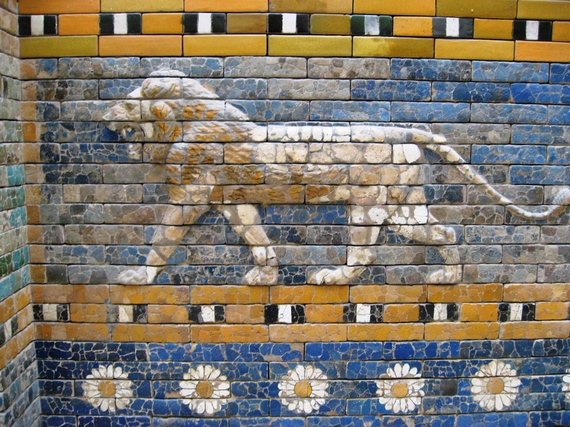Yesterday, I told the story of Ishtar and Tammuz as our Wisdom Story. You've probably heard of the Ishtar Gate, currently in the Pergamon Museum in Berlin, Germany, part of which is pictured below. Lions represent Ishtar in this depiction.
For Unitarian Universalists, the Wisdom Story can be an integral part of the worship service on Sundays. The Wisdom Story is often told by the Director of Religious Education with an eye toward educating, reminding, and engaging the whole crowd, regardless of age.
Our service this past Sunday focused on St. Cecilia's day - a day to remember and celebrate music. As part of my Wisdom Story, I wanted to remember and celebrate Tammuz, the Babylonian god who represented fertility and played a magical flute. Tammuz's story echoes the myth of Demeter raging down to Hades to rescue her daughter Persephone. In this story, Tammuz is killed by his mother, Ishtar (known even earlier in Ancient Sumer as Inanna), who later regrets her decision and storms down to the underworld to rescue and revive Tammuz so that there can be celebration, food, and music once again. In the end, she is only allowed to enter the underworld having given up all her divine finery wearing a plain robe, and it is her earnest regret and love for Tammuz that revives him. As she weeps, her tears save Tammuz by bringing him back to life, and Ishtar is reunited with her son for six months of each year when he can bring life and celebration to the earth. The other six months of each year he remains in the underworld, although the purpose of that isn't entirely clear.
Tammuz shows up in the Bible, too. Ezekiel 8:14-15 King James Version
14 Then he brought me to the door of the gate of the LORD's house which was toward the north; and, behold, there sat women weeping for Tammuz.
15 Then said he unto me, Hast thou seen this, O son of man? turn thee yet again, and thou shalt see greater abominations than these.
We remember Tammuz as the seasons change, as fall ends and winter embraces us. With Tammuz in the underworld for the time being, we have time to plan, to consider, to contemplate. Perhaps that is what Ishtar needed, time to remember just how much she loved Tammuz, even though he clearly annoyed her enough for her to kill him.
Ishtar is a powerful, beautiful, horrifying goddess capable of slaughtering her own son and changing her mind about it later. If even a goddess can change her mind and go through Hades to make her mistake right, what wrongs do we need to put right? With our tears, what do we revive, and how do we forgive ourselves?
By Unknown (Details of artist on Google Art Project) [Public domain], via Wikimedia Commons
